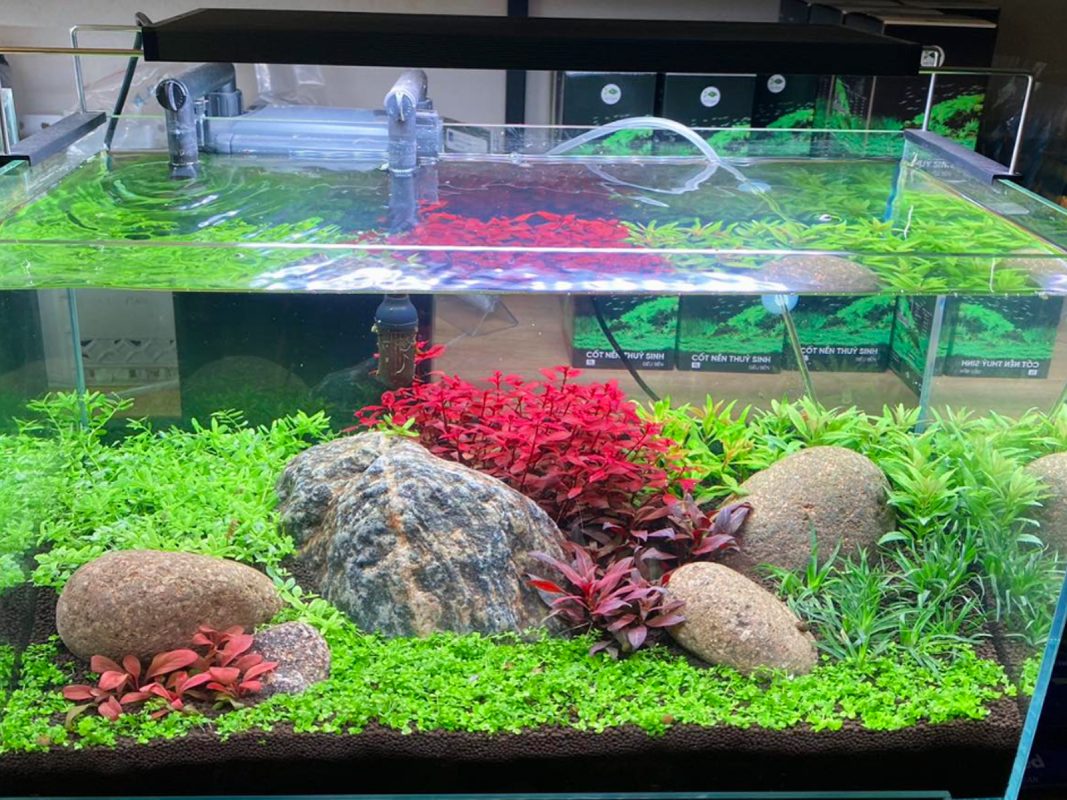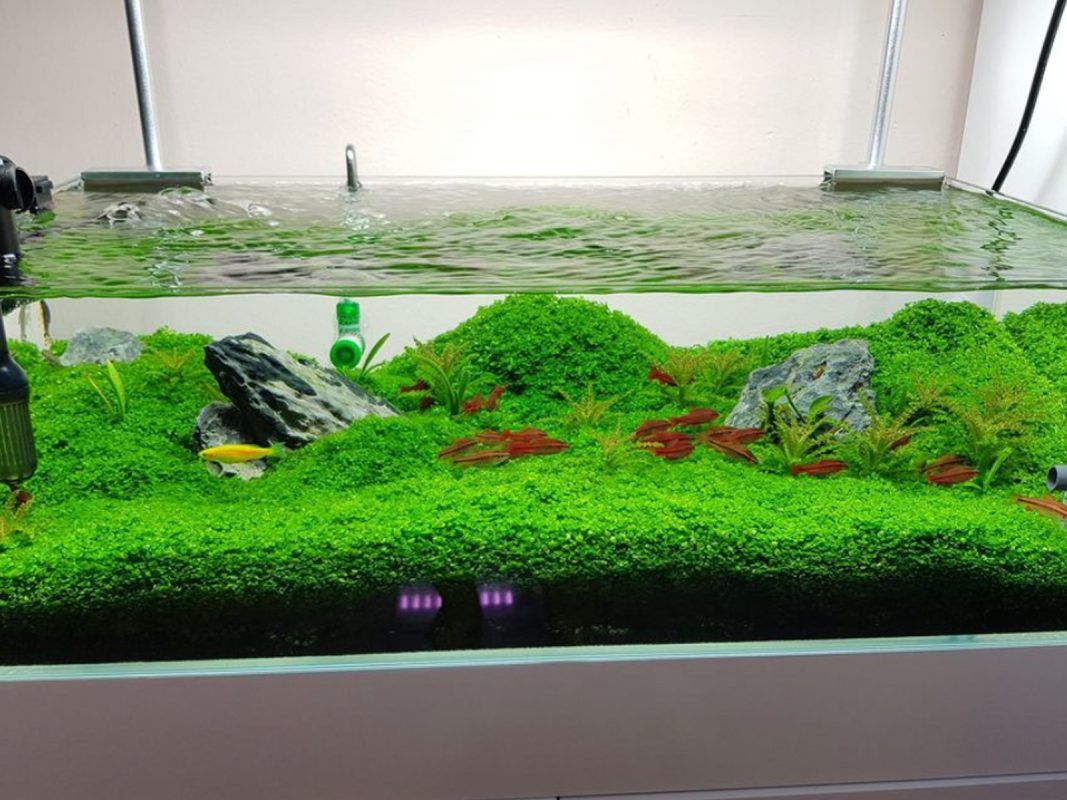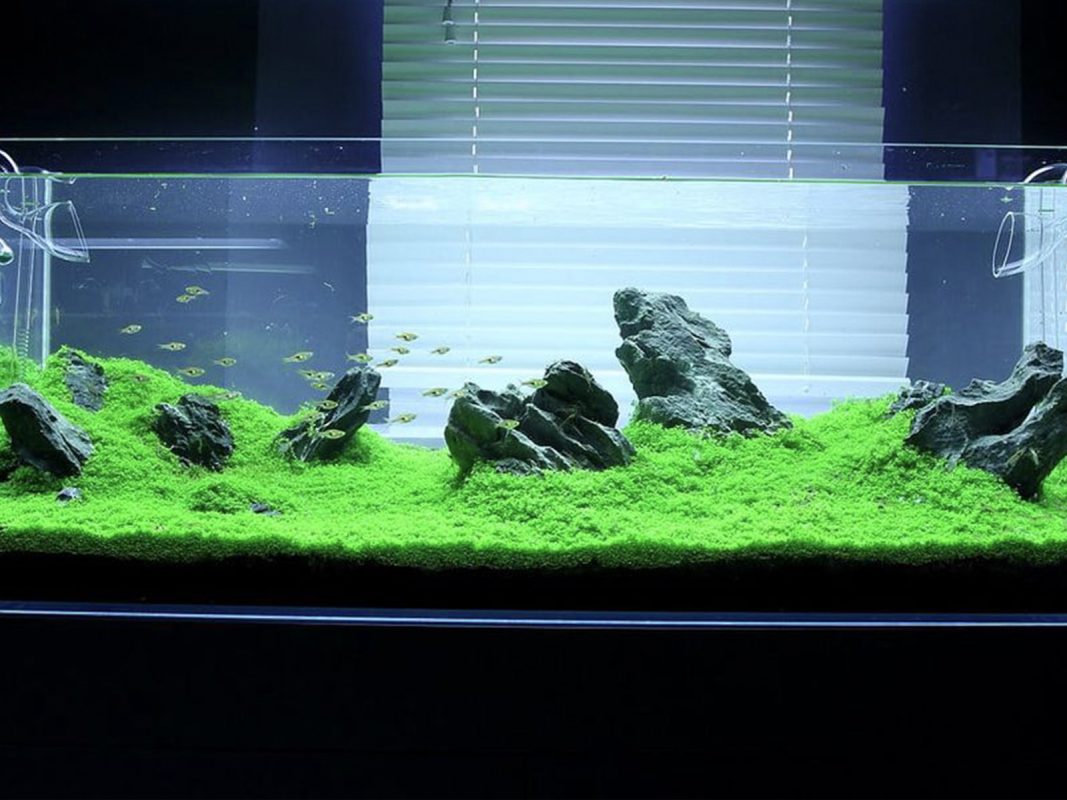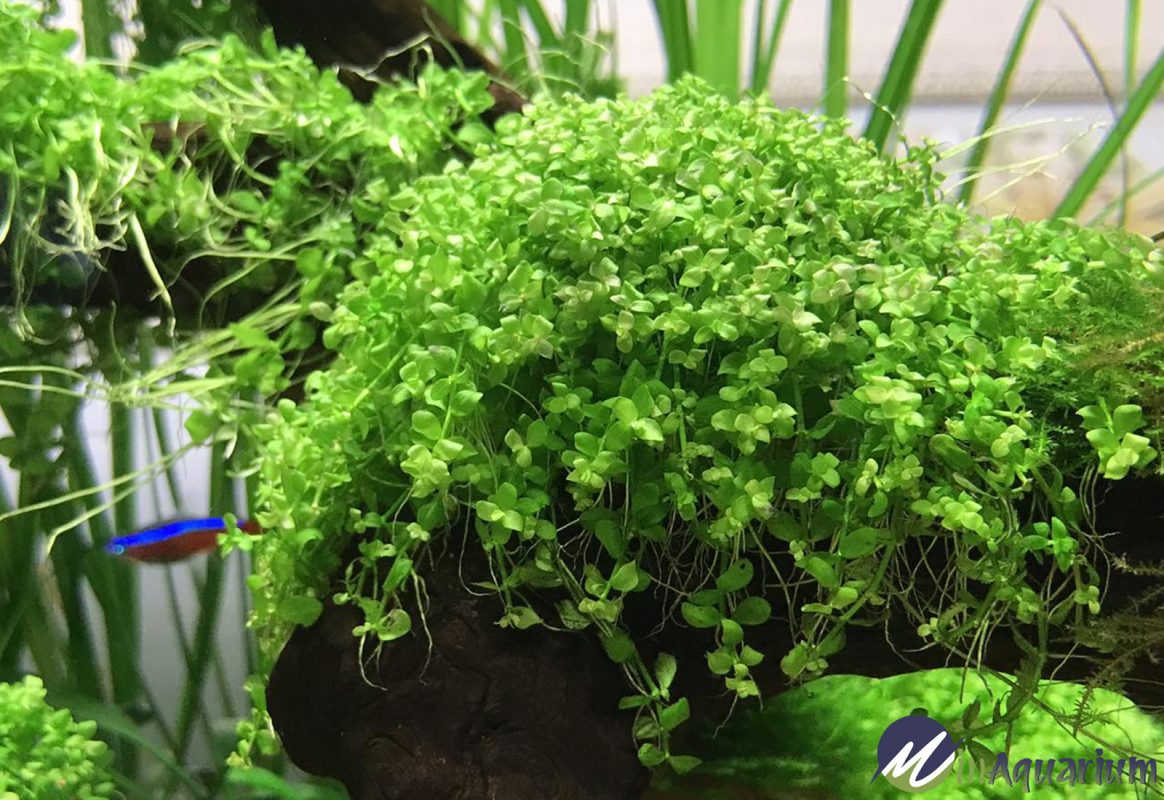Blogs
Micranthemum ‘Monte Carlo’ | A Comprehensive Guide
Aquascaping, the meticulous art of arranging aquatic plants, rocks, stones, and driftwood, brings aquarists closer to nature, allowing them to recreate diverse underwater landscapes. Among the array of aquascaping plants, none have captured the hearts of enthusiasts quite like Micranthemum ‘Monte Carlo’. This captivating, vibrant green plant with dense, mat-like growth provides not only a visual delight but also myriad benefits to the aquatic environment.
But what exactly is Micranthemum ‘Monte Carlo’? Why should you choose it over other carpeting plants? In this comprehensive guide, we’ll delve deep into understanding Monte Carlo’s characteristics, optimal tank conditions, planting techniques, care needs, compatibility with tank mates, and the common issues you might encounter. Whether you’re a seasoned aquarist or a novice taking your first dive into aquascaping, this guide will help you master the art of cultivating Micranthemum ‘Monte Carlo’.
What is Micranthemum ‘Monte Carlo’?
Micranthemum ‘Monte Carlo’, scientifically known as Micranthemum tweediei, originates from the dense, lush riverbanks of South America. It’s a popular choice among aquarists for its compact, carpet-forming abilities and vivid green foliage. This plant is also known by various names, including Bacopita, Monte Carlo Pearlweed, New Large Pearl Grass, and Tweedie’s Pearlweed.
The leaves of Micranthemum ‘Monte Carlo’ are small, rounded, and typically measure 0.2 to 0.4 inches (5 to 10 mm) in diameter. It grows to a height of 1-2.25 inches (3-6 cm), making it an ideal foreground plant. Unlike some carpeting plants that require specific environmental conditions, Monte Carlo is relatively adaptable, thriving in various tank setups.
The plant’s versatility and lush growth pattern make it a prized addition to both beginner and advanced aquariums. It not only enhances the aesthetic appeal of an aquarium but also provides numerous ecological benefits, such as oxygenation and nutrient absorption, contributing to a balanced and healthy aquatic ecosystem.

Why Choose Micranthemum ‘Monte Carlo’?
If you’re wondering why Micranthemum ‘Monte Carlo’ stands out among other aquatic plants, here are a few compelling reasons:
- Aesthetic Appeal: Monte Carlo’s small, rounded leaves and vibrant green color create a stunning, carpet-like effect. It adds a lush, vibrant green touch to the foreground of the aquarium, enhancing the overall visual appeal.
- Oxygenation and Filtration: This plant helps oxygenate the water through photosynthesis and absorbs excess nutrients, thus contributing to a healthy and balanced aquatic ecosystem.
- Low Maintenance: Micranthemum ‘Monte Carlo’ is relatively easy to care for compared to other carpeting plants. It doesn’t demand strict water parameters and can thrive in different lighting conditions, making it suitable for both novice and experienced aquarists.
- Compatibility: It is suitable for various tank sizes and can be paired with a wide range of fish and invertebrates, making it a versatile option for community tanks.
Investing in Micranthemum ‘Monte Carlo’ ensures you’re getting a hardy, aesthetically pleasing plant that plays a significant role in maintaining the health of your aquarium.
Appearance and Characteristics
Leaf Shape and Color
Micranthemum ‘Monte Carlo’ boasts small, rounded leaves that measure approximately 0.2 to 0.4 inches (5 to 10 mm) in diameter. These leaves form a lush carpet of light to medium green coloration, creating a visually appealing foreground in any aquarium setup. The plant’s leaves are reminiscent of tiny emeralds scattered across the substrate, lending a velvety texture to the aquascape.
The dense mat formed by these leaves not only looks attractive but also provides a natural habitat for small fish and shrimp to seek shelter. Imagine a vibrant, miniature forest floor beneath the water surface, providing a scenic backdrop for your aquatic inhabitants. The color and texture of Monte Carlo make it stand out, compared to other carpeting plants like Hemianthus callitrichoides (“Dwarf Baby Tears”), which tend to have smaller leaves and a more delicate appearance.
Growth Habit
Monte Carlo’s growth habit is one of its most endearing qualities. The plant spreads laterally, forming a thick carpet over the substrate. This creeping growth habit allows it to cover large areas relatively quickly when provided with the right conditions. It has a moderate to fast growth rate, meaning it will fill in gaps and establish a lush carpet faster than some other carpeting plants.
Unlike tall stem plants that grow upwards and require significant trimming, Micranthemum ‘Monte Carlo’ remains low and close to the substrate. This makes it an excellent choice for aquarists looking to achieve a dense, low-lying carpet in the foreground of their tank, without the worry of frequent top pruning. Its low-growing nature also makes it suitable for nano tanks, where space is limited, and a compact plant is desired.
Size and Dimensions
The dimensions of Micranthemum ‘Monte Carlo’ make it a versatile choice for various tank setups. It grows to a height of 1-2.25 inches (3-6 cm) and can spread extensively across the tank floor. This low-profile growth allows more light to penetrate deeper into the carpet, promoting healthier and denser growth.
In terms of coverage, Monte Carlo plants can occupy a substantial area of the substrate, providing a green carpet that enhances the overall aquascape. For example, in a 20-gallon tank, a single pot of Monte Carlo can be divided and planted to eventually cover the entire foreground, creating a seamless green carpet.
Given its dimensions and growth pattern, Monte Carlo is a popular choice for creating intricate aquascapes, whether for Dutch-style aquariums, where plants are arranged in layers, or Iwagumi layouts, where the emphasis is on minimalist rock and plant compositions.
Tank Setup and Conditions

Tank Size
When it comes to tank size, Micranthemum ‘Monte Carlo’ is incredibly adaptable. It can thrive in various tank sizes, from small nano tanks to larger aquariums. The minimum recommended tank size for Monte Carlo is 5 gallons (approximately 19 liters), allowing enough space for the plant to spread laterally and establish a carpet.
For larger tanks, such as those of 10 or 20 gallons (38 to 76 liters), Monte Carlo can provide even more room to thrive. In these larger setups, the plant’s rapid growth can cover wide areas, creating an expansive carpet that beautifully frames other taller plants or hardscape elements within the tank.
It’s also worth noting that Monte Carlo can be used in specialized setups like shrimp tanks or betta tanks. Its compact and low-growing habit makes it an excellent foreground or midground plant in these scenarios, adding texture and visual interest to the aquascape.
Water Parameters
Maintaining optimal water parameters is crucial for the healthy growth of Micranthemum ‘Monte Carlo’. Here are the recommended water parameters for this plant:
- Temperature: 68-77°F (20-25°C)
- pH: 6.0-7.5
- Hardness: Up to 15 GH
Monte Carlo can tolerate a range of water conditions, making it suitable for both soft and hard water setups. However, stable water parameters are essential for the plant’s health and growth. Sudden fluctuations in temperature, pH, or hardness can stress the plant and hinder its development.
Monitoring water parameters regularly and making adjustments as needed will ensure that Monte Carlo thrives in your aquarium. Utilizing a reliable water testing kit can help keep track of these parameters and ensure they remain within the recommended ranges.
Lighting
Lighting plays a pivotal role in the success of Micranthemum ‘Monte Carlo’. This plant requires moderate to high lighting to achieve dense, compact growth. The ideal light intensity for Monte Carlo is in the range of 50-70 PAR (Photosynthetically Active Radiation).
Providing the right light intensity and duration is key to promoting the lateral, carpet-like growth that makes Monte Carlo so attractive. Aim for 6-8 hours of light per day to ensure the plant receives adequate light for photosynthesis.
- Lighting Intensity: 50-70 PAR
- Lighting Duration: 6-8 hours per day
Inadequate lighting can cause Monte Carlo to grow upwards instead of spreading horizontally, resulting in a less desirable appearance. On the other hand, too much light can lead to algae growth. Balancing light intensity and duration is crucial to achieving a healthy and vibrant Monte Carlo carpet.
Substrate
A nutrient-rich substrate is essential for the healthy growth of Micranthemum ‘Monte Carlo’. This plant is a “root feeder,” meaning it absorbs nutrients primarily through its roots. Therefore, choosing the right substrate is paramount.
A fine-grained or small-grained substrate is recommended for Monte Carlo, as it allows the shallow roots to establish and spread effectively. Some popular nutrient-rich substrates for Monte Carlo include:
- Caribsea Eco-Complete
- Seachem Flourite
- Fluval Stratum
Before planting, slightly dampening the substrate can make the planting process easier and ensure the plants remain anchored. This step is particularly important when planting tissue culture Monte Carlo, as it helps the delicate roots settle into the substrate more securely.
Fertilizer
While external fertilization and CO2 dosing are not mandatory for Micranthemum ‘Monte Carlo’, they significantly enhance the plant’s growth and health. Providing additional nutrients and CO2 can promote faster, denser, and more compact growth.
- Liquid Fertilizers: Using liquid fertilizers like Seachem Flourish can provide essential nutrients such as nitrogen, phosphorus, potassium, and micronutrients. Dosing liquid fertilizers according to the manufacturer’s recommendations can help ensure the plant receives the necessary nutrients.
- CO2 Injection: Periodic CO2 injection into the tank water can improve Monte Carlo’s growth and prevent yellowing of the leaves. CO2 supplementation can be particularly beneficial in high-light setups, as it enhances photosynthesis and overall plant vitality.
For those keeping shrimp in their tanks, it is essential to read articles on CO2 in shrimp tanks and use shrimp-safe plant fertilizers. Shrimp are sensitive to CO2 levels, and careful monitoring is necessary to ensure their well-being.
Planting and Propagation

Planting Technique
Planting Micranthemum ‘Monte Carlo’ can be a straightforward process when done correctly. Here’s a step-by-step guide to help you get started:
- Acquiring the Plant: Purchase potted Monte Carlo plants from a trusted pet store or online vendor. Typically, 1-2 pots are sufficient for a 5-10 gallon tank.
- Preparing Tissue Culture Monte Carlo: If using tissue culture Monte Carlo, remove it from the container and rinse off the nutrient gel thoroughly. Divide the plant into 8-10 small pieces.
- Preparing Nursery-Grown Monte Carlo: If using nursery-grown Monte Carlo, remove the pot and detach the rock wool. Rinse the plant thoroughly to remove any remaining debris.
- Planting: Plant each piece into the substrate, ensuring the roots are deeply embedded to prevent detachment. For tissue culture plants, plant the divided sections close to each other to achieve a dense carpet more quickly.
Regularly misting the plant and substrate during the planting process can help keep the Monte Carlo hydrated and improve the chances of successful rooting.
Propagation Methods
Micranthemum ‘Monte Carlo’ can be propagated through various methods, including division, stem cuttings, and carpeting techniques. Here’s how you can propagate this plant effectively:
- Division: Divide the plant into multiple sections, each containing roots and stems. Plant each section individually into the substrate. This method is particularly useful when you want to expand the carpet or fill in gaps.
- Stem Cuttings: Take 2-3 inch long stem pieces with a node, remove the lower leaves, and plant them into the substrate. Ensure that the cuttings are planted deeply enough to remain anchored while the roots develop.
- Carpeting: Plant small sections of Monte Carlo close together to form a dense carpet. This method is often used when establishing a new Monte Carlo carpet in a fresh tank setup. Proper lighting, CO2 supplementation, and a nutrient-rich substrate are vital for successful propagation.
Propagation not only helps in expanding your Monte Carlo carpet but also rejuvenates the plant by stimulating new growth. Regular propagation and replanting can help maintain a lush and vibrant carpet over time.
Care and Maintenance

Trimming and Pruning
Regular trimming and pruning are essential to manage the growth of Micranthemum ‘Monte Carlo’ and maintain its carpet-like appearance. Here’s a guide to effective trimming and pruning:
- Initial Trimming: The first time you trim your Monte Carlo, it may take longer than subsequent trims. Use trimming scissors to cut the plants down to a little less than half an inch (approximately 1 cm) above the substrate. This promotes lateral growth and denser carpeting.
- Regular Trims: Perform regular trims every 2-3 weeks to maintain the desired shape and size of the carpet. Trim any overgrown sections and remove any unhealthy or dead plants to prevent them from affecting the overall health of the tank.
- Removing Trimmed Pieces: Make sure to remove any trimmed pieces from the tank, as they can dirty the aquarium and increase ammonia levels, which can harm other tank inhabitants.
Regular trimming not only keeps the Monte Carlo carpet looking neat and tidy but also encourages new growth and prevents the lower parts of the plant from becoming shaded and dying off.
Regular Water Changes
Maintaining optimal water parameters is crucial for the health and growth of Micranthemum ‘Monte Carlo’. Regular water changes help replenish nutrients, remove waste, and keep the water quality high. Here’s a guide to performing regular water changes:
- Frequency: Aim for a water change schedule of 25-50% every 1-2 weeks, depending on the tank’s size and bioload. More frequent water changes may be necessary for heavily stocked tanks or those with higher nutrient demands.
- Monitoring Water Parameters: Regularly check water parameters such as pH, temperature, and hardness to ensure they remain within the recommended ranges. Adjust water changes as needed to maintain stable and optimal conditions for Monte Carlo.
- Replenishing Nutrients: During water changes, consider dosing liquid fertilizers to replenish any nutrients that may have been removed. This ensures that the Monte Carlo plants continue to receive the necessary nutrients for healthy growth.
Regular water changes are vital for preventing nutrient deficiencies and maintaining a healthy and balanced aquatic environment for both the plants and tank inhabitants.
Algae Control
Micranthemum ‘Monte Carlo’ can be susceptible to algae growth if the tank conditions are not properly maintained. Here are some tips for controlling algae and promoting healthy Monte Carlo growth:
- Adequate Lighting and CO2 Levels: Ensure that the lighting intensity and duration are appropriate for Monte Carlo. Insufficient lighting can lead to algae growth, while too much light can cause the plants to grow upwards instead of carpeting. CO2 supplementation can help outcompete algae and promote healthy plant growth.
- Nutrient Balance: Maintaining a balanced nutrient regime is crucial for preventing algae growth. Avoid over-fertilizing, which can lead to excess nutrients in the water and promote algae.
- Regular Water Changes: Perform regular water changes to remove excess nutrients and improve water quality. This helps prevent algae from gaining a foothold in the tank.
- Manual Removal: Remove any visible algae manually during regular tank maintenance. This helps keep the tank clean and prevents algae from spreading.
- Algae-Eating Tank Mates: Consider adding algae-eating tank mates such as shrimp or certain fish species to help control algae growth. These tank mates can help maintain a clean and thriving aquarium environment.
By following these care and maintenance guidelines, you can ensure the long-term health and success of your Micranthemum ‘Monte Carlo’ plants in your aquarium.
Tank Mates
Compatible Fish Species
Choosing the right tank mates for Micranthemum ‘Monte Carlo’ is essential for maintaining a harmonious and thriving aquarium. Here are some suitable fish species that can coexist with Monte Carlo plants:
- Cardinal Tetras: These small, peaceful fish are known for their vibrant coloration and schooling behavior. They do well in planted tanks and can thrive alongside Monte Carlo carpets.
- Clown Loach: Despite their larger size compared to tetras, Clown Loaches are peaceful and can coexist with Monte Carlo. They may occasionally dig in the substrate, so ensure the plants are well-rooted.
- Mollies: Mollies are hardy and adaptable fish that can coexist with Monte Carlo plants. They are known to graze on algae, which can help control algae growth in the tank.
- Neon Tetras: Similar to Cardinal Tetras, Neon Tetras are small, peaceful fish that do well in planted tanks. Their striking blue and red coloration adds a pop of color to the aquascape.
- Rasbora Hets: These small, schooling fish are peaceful and make excellent tank mates for Monte Carlo. Their active swimming behavior adds movement and life to the aquarium.
Compatible Invertebrates
In addition to fish, certain invertebrates can coexist harmoniously with Micranthemum ‘Monte Carlo’. Shrimp are particularly suitable tank mates for Monte Carlo plants:
- Shrimp: Various species of shrimp, such as Cherry Shrimp, Amano Shrimp, and Ghost Shrimp, can thrive in tanks with Monte Carlo. These shrimp are known for their algae-eating capabilities, which can help control algae growth. They also benefit from the dense carpet, using it as shelter and foraging for food.
Shrimp are generally gentle and won’t disturb the Monte Carlo carpet, making them ideal tank mates for planted aquariums.
Troubleshooting Common Issues
Plant Melt
Plant melt is a common issue that aquarists may encounter with Micranthemum ‘Monte Carlo’ shortly after planting. Plant melt occurs when the plant’s leaves turn translucent and die off due to stress or unfavorable conditions. Here’s how to address plant melt:
- Water Changes: High nitrite levels can cause plant melt. Performing a water change can help reduce nitrite levels and prevent further melting.
- Stabilize Water Parameters: Ensure that water parameters such as temperature, pH, and hardness remain within the recommended ranges for Monte Carlo. Sudden fluctuations can stress the plant and lead to melt.
- CO2 Supplementation: Providing adequate CO2 levels can help the plant acclimate to the new environment and reduce the risk of melt. CO2 supplementation promotes healthy growth and resilience.
Brown Leaves
Brown leaves on Monte Carlo plants can be an indication of several issues:
- Insufficient Lighting: If the leaves are turning brown, it may be due to insufficient lighting, with the base of the plant not receiving enough light as the carpet grows thicker. Regular trimming is necessary to allow light to reach the lower portions of the plant.
- Nutrient Deficiencies: Nutrient deficiencies can also cause leaves to turn brown. Using a nutrient-rich substrate, such as Seachem Flourite or Caribsea Eco-Complete, can help provide the necessary nutrients for healthy growth.
Supplementing with liquid fertilizers designed for planted aquariums can also address nutrientdeficiencies and promote vibrant growth. Pay special attention to dosing with macro and micronutrients historically lacking in your tank to ensure Monte Carlo’s health.
Detachment from Substrate
A common issue, especially when first planting Micranthemum ‘Monte Carlo’, is its tendency to detach from the substrate before the roots have had time to anchor. Here’s how to address this issue:
- Proper Planting Technique: Ensure the pieces are planted deeply enough into the substrate. Shallow planting is a common mistake that leads to detachment. Use tweezers to carefully plant each section, making sure the roots are well-covered by the substrate.
- Weighing Down: In cases where Monte Carlo sections still come loose, consider using small plant weights or mesh to temporarily hold them in place until the roots establish.
- Maintain Optimal Conditions: Ensuring the plant has the right conditions, including adequate lighting, CO2, and nutrients, encourages quicker rooting and stronger anchoring. Strong, healthy roots are less likely to detach.
Regularly checking and replanting any loose sections will help establish a stable and dense carpet over time.
Benefits of Micranthemum ‘Monte Carlo’

Aesthetics and Aquascaping
The aesthetic appeal of Micranthemum ‘Monte Carlo’ is undeniable. Its small, rounded leaves create a lush, vibrant green carpet that transforms the foreground of any aquarium. This plant is incredibly versatile and can be used in various aquascaping styles:
- Dutch Style: In Dutch aquascapes, Monte Carlo can be used to create dense, vibrant green pathways or patches, adding contrast and depth to the layout.
- Iwagumi Layouts: In Iwagumi layouts, where minimalism is key, Monte Carlo’s low-growing, mat-like appearance creates a serene, natural foreground that complements the carefully placed rocks.
- Nature Aquariums: Inspired by natural landscapes, Monte Carlo can mimic meadows or grasslands, providing a realistic and serene environment for tank inhabitants.
- Nano Tanks: In smaller tanks, Monte Carlo’s compact growth helps create a lush, detailed foreground without overwhelming the limited space.
Its ability to cascade over rocks and driftwood adds another dimension to the aquascape, making it a popular choice for intricate and high-impact designs.
Habitat for Fish and Shrimp
Micranthemum ‘Monte Carlo’ creates an ideal habitat for various small fish and shrimp species. The dense carpet provides cover and places to hide, which is especially beneficial for small fish, fry, and invertebrates.
For shrimp keepers, Monte Carlo offers an excellent surface for biofilm growth, a primary food source for shrimp. Additionally, the carpet provides shelter, helping protect shrimp from potential predators and reducing stress levels.
Water Quality Improvement
Micranthemum ‘Monte Carlo’ also plays a significant role in improving water quality. Through photosynthesis, the plant absorbs CO2 and releases oxygen, helping maintain a healthy and balanced aquatic environment. This oxygenation is crucial for the well-being of fish and invertebrates.
Moreover, Monte Carlo plants absorb excess nutrients, such as nitrates and phosphates, from the water column. This nutrient uptake helps prevent algae growth and keeps the water clear and healthy.
In essence, incorporating Monte Carlo into your aquarium not only enhances its aesthetic appeal but also supports a healthier, more balanced ecosystem.
Conclusion
Final Thoughts
Micranthemum ‘Monte Carlo’ is undoubtedly a gem in the world of aquascaping. Its lush, vibrant green carpet adds an unparalleled aesthetic appeal to aquariums, whether they are small nano setups or expansive show tanks. Beyond its beauty, Monte Carlo offers practical benefits such as oxygenation, nutrient absorption, and shelter for small fish and invertebrates, making it a valuable addition to any planted tank.
Its ease of care and adaptability to various tank conditions make it an excellent choice for both beginners and experienced aquarists. With proper planting, maintenance, and attention to water parameters, you can enjoy a thriving Monte Carlo carpet that enhances the visual and ecological balance of your aquarium.
Resources and Further Reading
For those looking to expand their knowledge and skills in cultivating Micranthemum ‘Monte Carlo’, several resources provide detailed information and expert tips. Here are some recommended readings:
Monte Carlo Aquarium Plant Care Guide [Expert Tips & Tricks]: A comprehensive overview of the plant’s requirements, including lighting, substrate, fertilization, and maintenance.
Monte Carlo – Fresh Water Aquatic Plant Guides & Resources: A go-to resource for cultivating and caring for Monte Carlo plants, offering practical advice and troubleshooting tips.
Mastering Monte Carlo: A Comprehensive Freshwater Plant Guide: An in-depth guide covering the plant’s origin, importance in aquascaping, and step-by-step planting instructions.
The Complete Guide to Monte Carlo Plant Care – Fishkeeping World: Detailed information on the plant’s background, growth habits, and optimal care conditions.
Monte Carlo Care 101: Tips for Vibrant and Lush Growth: A thorough guide providing 2000 words of practical advice on setting up the perfect environment for a thriving Monte Carlo carpet.
Monte Carlo Plant (Micranthemum Tweediei): Ultimate Care Guide: A robust guide to understanding the plant’s scientific name, appearance, and cultivation.
Care Guide: Micranthemum tweediei – HYGRONATURE: Focused on the essential factors for growing Micranthemum tweediei successfully.
By utilizing these resources along with the insights provided in this guide, aquarium enthusiasts can cultivate a beautiful and healthy Micranthemum ‘Monte Carlo’ carpet, transforming their aquascapes into lush, vibrant underwater landscapes.

